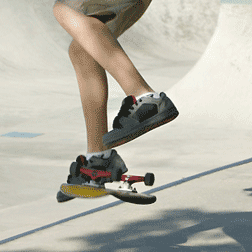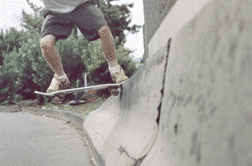|
 |
||||||||||||||||
Finding Common Ground
|
|||||||||||||||||
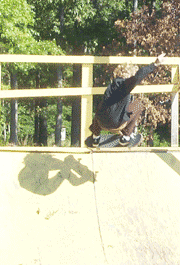 |
Randy Lyvers, above, rides the pipe at Cedar Grove United Methodist Church. With its concrete bowl, the Bowie Skate Park at Allen Pond, below, gives skaters a place to take their skills to the next level. |
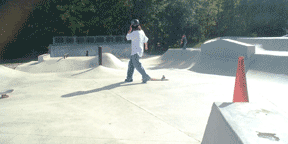 |
e Arundel County built kids places to skate, even incorporating skateboarding into their youth programs.
Finding common ground requires compromise and sacrifice from both boarders and youth ministers. The church must loosen its traditions, and the skateboarders must make concessions to more strident safety standards.
Altering Their Approach
Churches are “meeting kids where they are,” says Joe Heinrich, former youth pastor at Cedar Grove and architect of the skate park project.
The kids of Cedar Grove’s youth group have taken up skateboarding with such zeal that the church at first allowed them to skate in the sanctuary. Now, the church is seeking to raise $25,000 to build a permanent skate park in the back yard. Yard sales, donations and an annual dog party have helped raise some $19,000, enough money to pour the 5,000-square-foot slab of concrete that will provide the foundation for the park. But the concrete is only phase one, according to Arvak Marshall, youth minister at Cedar Grove. They still need to raise money for ramps, pipes and a fence.
“We just want [kids] to feel loved,” said Marie Lilly, a youth leader at Cedar Grove. “We want to provide a safe environment for kids to have fun. Around here, there’s not much to do but get in trouble.”
If You Build it,Will They Come?
Skateboarding can bring trouble. It started as a counter-culture sport, and the rebel attitude of boarders is still common as they glide through no skate zones from shopping malls to playgrounds. But not all skateboarders are rebels without a cause; they board through banned areas because they lack options. Skate parks can be difficult to get to, and their safety restrictions take some of the rebellious fun out of the sport.
Fourteen-year-old David Dan of Bowie spends his free time and much of the money he earns as a bag boy at Giant on skating. The Bowie Skate Park at Allen Pond gives him a place to use his much worked-for skills. Because the Bowie Skate Park has a bowl, Dan described it as more advanced than the other courses.
|
Skate Talk Brush up your skate-speak with this quick guide to terms. Half-pipe: A crescent-shaped ramp, commonly used in trick competitions. Rail grind: Scraping one or both skateboard axles on a railing. The grind can also be performed on the lips of ramps or other structures.
360: Basic revolutionary trick, where the boarder spins in air 360 degrees. Kick flip: Skaters jump, kicking the board and causing it to flip before they land. Tailslide: Sliding the back of the board along an edge or railing during a grind trick.
|
Skating is free at Allen Pond after boarders register with the city, a process that includes a $10 fee. An attendant keeps an eye on the skate park, and kids feel the pressure to keep their safety gear on in Bowie, even when the supervisor isn’t around.
“You have to wear your helmets,” said Darius Butler, a 16-year-old skater. He prefers Allen Pond, built in the summer of 2006, but he opts to skate in Dunkirk to avoid the attendant. “Everybody hates wearing helmets and kneepads.”
Dunkirk District Park in Calvert County is an unsupervised skate park — and it’s free. By reputation, the Dunkirk park is well used and uncomfortable for younger kids. “A lot of older guys hang out there,” said Randy Lyvers.
To find freedom from pads, or to look cool on their boards, skaters must traverse the county for other public parks.
Sawmill Skate Park in Glen Burnie, built in 2002, is smaller than the Bowie park, but it is well kept and built for all skating skill-levels to enjoy, according to the park’s facility superintendent, John Stinnenweber. Like Bowie, it is open during daylight hours, and there is no fee to skate.
“Not one kid has a helmet,” said Diane Bloom, who watched her son skate from nearby bleachers. Bloom said convincing her son to stick out from the crowd and wear a helmet is a losing battle for her. “I wish there was a rule,” she said.
There is a rule, just no one to enforce it. Signs outside the park require kids to don their pads and helmets. When the park opened, a supervisor kept an eye on skaters, who paid a fee to use Sawmill. Too few kids showed up to warrant an attendant, according to Stinnenweber, so the fee and the supervisor are gone. Without the two, the park is much more popular.
Truxtun Park in Annapolis is another option for skaters. As at Sawmill, there is no attendant watching to make sure kids stay safe. That’s one reason Kolby Hawkins-el, 14, skates at Truxtun, even though he acknowledges the Bowie Skate Park is nicer. But Truxtun is often packed, said Hawkins-el, and he feels the need for new skate parks. “There are too many skaters and too few parks,” he said.
Sermons on the Ramp
Churches like Cedar Grove, St. Paul’s and Friendship Community are trying to fill that need. Simply opening a slab of concrete wasn’t enough; the churches had to attract freedom-seeking teens and deliver their message.
Church skateboard parks require the disdained safety gear and frequently draw novice skaters to their concrete sanctuaries. Many of the skaters at Cedar Grove are still learning their moves and are not yet ready for the Bowie Park. But of all the area skate parks, Bowie Skate Park seems to be closest to what Cedar Grove is trying to build: a safe and popular facility. One difference is that Cedar Grove plans skating sessions for each age group, so young or old boarders can have the course to themselves for a time.
Other churches are already evangelizing kids with skate parks.
At Friendship Community, where the church has built a wooden half-pipe next to its beach volleyball court, Steve Van Rees, leader of the skate program, supervises skating sessions on Tuesday evenings and Saturday mornings during the warmer months. Midway though the sessions, Van Rees int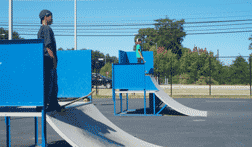 errupts the skating to give a message about God’s love and the Bible.
errupts the skating to give a message about God’s love and the Bible.
Dave Showalter, who heads up the skate ministry at St. Paul’s, delivers a similar presentation midway through the skate night on Mondays and Fridays, depending on the season. Showalter sees the talk as a very important part of the skate ministry. “About 75 percent of these kids don’t attend church. I think they see the skate thing as church,” Showalter says.
Joe Heinrich, now a youth pastor at Mid Atlantic Community Church, believes it is the responsibility of the churches to take their message onto skate ramps. “If a good way of reaching people is to play Bingo,” he said, “let’s do that. If it is square dancing, let’s do that. Whatever’s effective. Let’s not get hung up on tradition.” Skateboarding just so happens to be what reaches kids at this moment.
“Axiom One of youth ministry is to find a comfortable way of entering into the student’s world,” says Mark Senter III. The professor of educational outreach at Trinity Evangelical Divinity School in Deerfield, Ill., traces churches and skate parks back 10 or 15 years.
Church skate parks popping up across the Chesapeake area reflect more than a sports fad. According to Heinrich, churches are catching up with the culture. “Christians need to shape culture. Like in the old days, cities would be built around the church,” Heinrich says. Cedar Grove tries to be relevant to teens in other ways, as well. Its youth group organizes concerts at the church and has special Sunday morning meetings on exploring God through art.
Church efforts to relate to teens may be accelerating as more and more choose to employ youth pastors, who can focus their time on understanding young people, according to Senter, author of the book Four Views of Youth Ministry and the Church. “There has been a collapse of community. Our families are isolated. We owe it to families to help kids,” says Senter, explaining that churches try to provide this “help” by hiring full-time youth pastors.
|
Skate Sites The Bowie Skate Park at Allen Pond 3330 Northview Drive, Bowie: 301-262-6200 • Open year-round, dawn to dusk Cedar Grove United Methodist Church Mason’s Beach Road, Deale: 410-867-7417 • Open year-round anytime except Sunday mornings Dunkirk District Park 10750 Southern Maryland Blvd., Dunkirk: 410-535-1600 • Open year-round, weekdays and Saturdays 8:30am-4pm; Sundays noon-4pm. Summer hours: weekdays and Saturdays 8:30am-11pm; Sundays noon-11pm Friendship Community Baptist Church 37 Jewell Road, Dunkirk: 410-741-5715 • Open summer and weather allowing, Tuesdays 6-7:30pm; Saturdays 10am St. Paul’s United Methodist Church 11000 HG Trueman Road, Lusby: 410-326-4475 Open June 23 thru August 25, Mondays 6-8pm: September 5 thru 26, Fridays 5-7pm Sawmill Skateboard Park 301 Dorsey Road, Glen Burnie: 410-222-0017 • Open year-round, dawn-dusk Truxtun Skate Park Off Hilltop Lane, Annapolis: 410-263-7958 • Open year-round, 9am-dusk |
Are these new tactics working?
Cedar Grove attracts large numbers of teenagers to church throughout the week because of its ramps and pipes. At Friendship Community, kids seem appreciative of the church’s efforts to provide a place to skate, but few attend its youth group, says Glen Beach, who helps run the skate ministry.
But skateboarder Luke Beach, Glen Beach’s 11-year-old son, said the ministry helps his friends change their idea of churches. They “think our skateboarding nights are a little bit unusual,” he said. “But people say they really like it. They feel okay about the talk and don’t care because it’s only 10 minutes.” Given mobility, though, Beach says most kids would rather go to the Dunkirk skate park, where there is more equipment and they don’t have to wear protective gear.
Resurrecting the Park
The scarcity of nearby skate parks with a positive atmosphere leaves the kids at Cedar Grove skating on old wooden ramps and quarter-pipes in the lot behind their church. Piles of upturned rubble and dirt in the area behind the lot are the only clues that there will be a park here one day.
Once the skate park is up and running, kids will have to enjoy fun in an organized fashion; skating will be supervised, and it won’t be a free-for-all. Similarly, adults are always on hand at St. Paul’s and Friendship Community, making sure that kids are safe and that they take turns on the equipment.
Back at Cedar Grove, Randy Lyvers and Jared Voorhees demonstrated their skateboarding tricks during a dog party, one of the skate park fundraisers. Randy’s mother, Dannye Lyvers, headed up the fundraising and washed up in the church kitchen while her son rolled through 360s and Ollies.
Heinrich’s theory — that youth group skate parks send a different message about the church — may be true. They also send a different message about skaters as renegades. The church skate parks have brought parents and kids together, as they work to raise money or organize events, and the stereotype of the rebellious skater seems debunked among many of the adults.
“I wish parents could see the kids at our skate nights,” says Showalter, youth pastor from St. Paul’s. “They show better courtesy than the drivers on the road.”
Bethany Rodgers, Bay Weekly’s 2007 summer intern, is finishing her journalism degree at the University of Maryland. Help her find a full-time reporting job: [email protected].
|
Current Issue \\ Archives \\ Subscriptions \\ Clasified Advertising \\ Display Advertising |

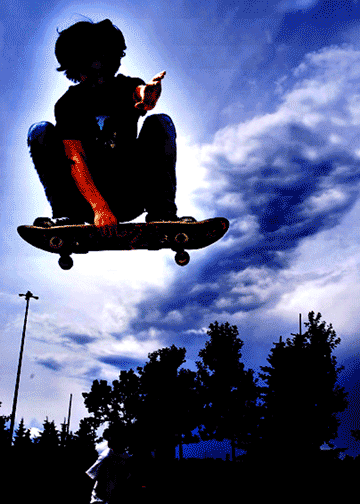

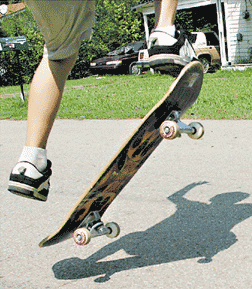 Ollie: A jump where all four wheels leave the ground; the skateboarder does not touch the board. The foundation for many aerial tricks.
Ollie: A jump where all four wheels leave the ground; the skateboarder does not touch the board. The foundation for many aerial tricks. 